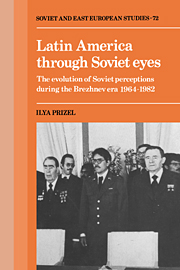 Latin America through Soviet Eyes
Latin America through Soviet Eyes Book contents
- Frontmatter
- Contents
- Preface
- Acknowledgments
- Introduction
- Part I Soviet perceptions of Latin America's global role
- Part II Soviet perceptions of Latin American social structures
- Introduction
- 6 The Latin American church
- 7 The Latin American armed forces
- 8 Latin American labor unions
- 9 Bourgeois political parties
- 10 Wars of national liberation or peaceful transformation?
- Part III Soviet–Latin American relations during the Brezhnev era
- Part IV Conclusion: the emerging Soviet perception of Latin America and the future of Soviet policy toward the hemisphere
- Conclusions
- Epilogue – Latin America: the Long March
- Notes
- Bibliography
- Index
- Frontmatter
- Contents
- Preface
- Acknowledgments
- Introduction
- Part I Soviet perceptions of Latin America's global role
- Part II Soviet perceptions of Latin American social structures
- Introduction
- 6 The Latin American church
- 7 The Latin American armed forces
- 8 Latin American labor unions
- 9 Bourgeois political parties
- 10 Wars of national liberation or peaceful transformation?
- Part III Soviet–Latin American relations during the Brezhnev era
- Part IV Conclusion: the emerging Soviet perception of Latin America and the future of Soviet policy toward the hemisphere
- Conclusions
- Epilogue – Latin America: the Long March
- Notes
- Bibliography
- Index
Summary
Latin America, although a part of the Third World, has several characteristics that make it unique among developing continents. Unlike Asia and Africa, Latin America is basically dominated by a single linguistic and cultural pattern. However, the belief that all Latin American countries are identical because of the predominance of the Iberian languages and Catholicism is, of course, incorrect. Nevertheless, with the exception of the Arab world, Latin America is unique in its cultural communality.
Latin America's level of economic and social development certainly makes the region a part of the Third World. As part of the global economic periphery, it relies on the export of primary commodities and the import of capital and industrial goods. Yet Latin America is far more developed than Africa and most of Asia. As a result of significant industrial development, some initiated as early as the 1930s and further accelerated during and after World War II, Latin American society is far more developed, with an older and a more distinct urban population than that of most developing regions. Thus, while much of Latin America still retains its traditional social structure of latifundism, parts of the continent are now heavily industrialized, and a large proletariat and middle class have entered the Latin American political panorama.
Unlike most of the Third World, where the majority of the existing states are less than fifty years old, almost all Latin American states attained their independence by the 1820s, and thus the tradition of a nation-state is more established in Latin America than in many other parts of the world.
- Type
- Chapter
- Information
- Latin America through Soviet EyesThe Evolution of Soviet Perceptions during the Brezhnev Era 1964–1982, pp. 69 - 71Publisher: Cambridge University PressPrint publication year: 1990
